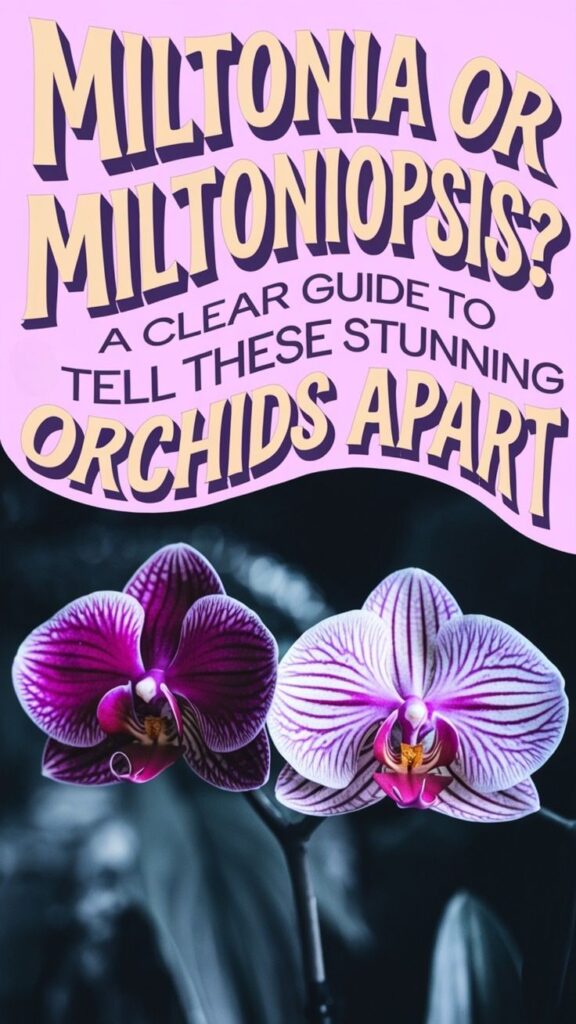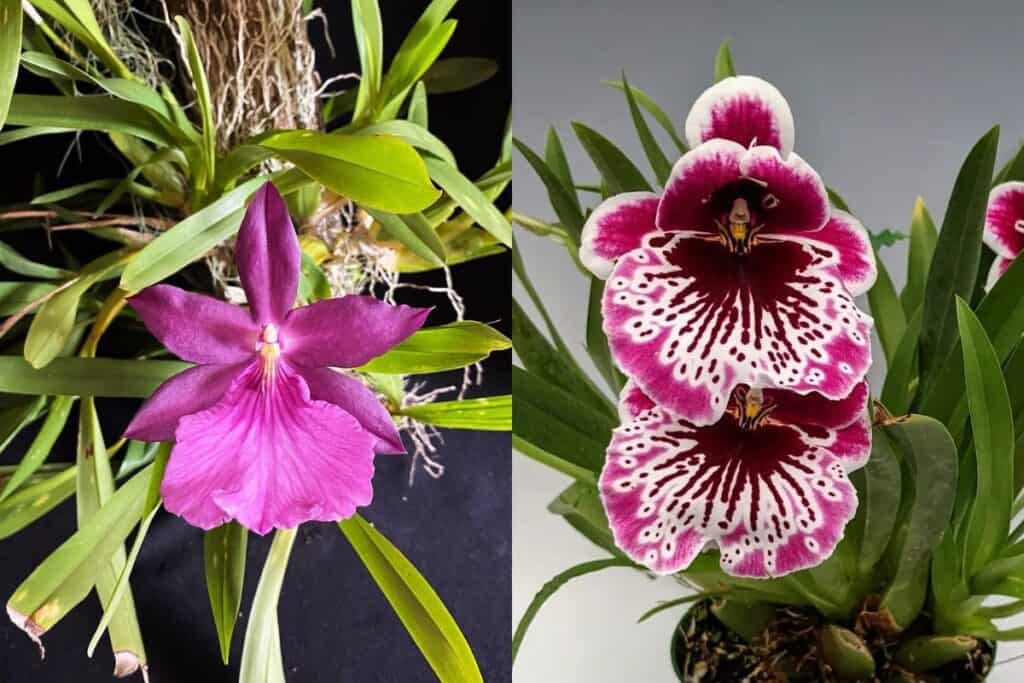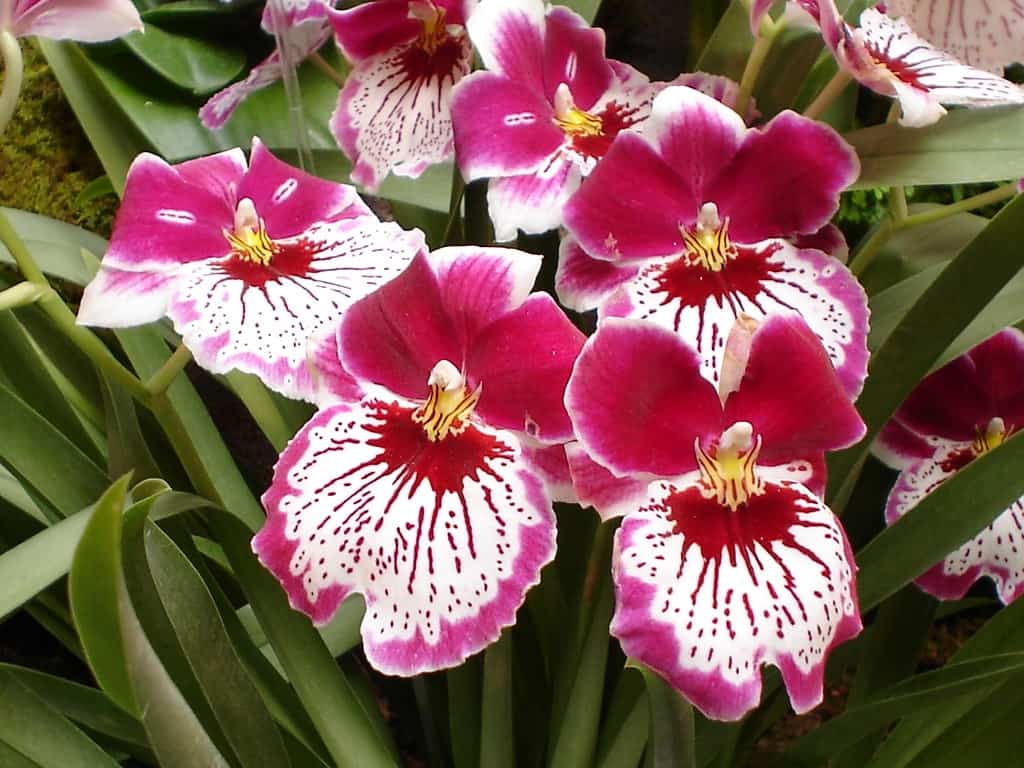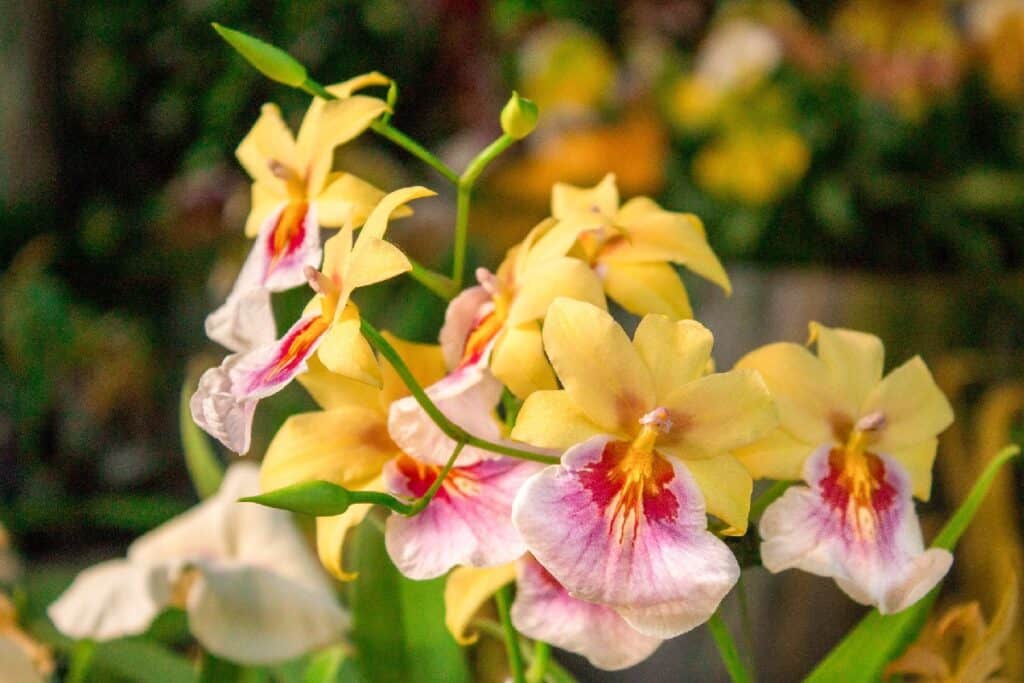It’s often confusing to tell Miltonia and Miltoniopsis apart. Both of these orchid species are popular household plants, but they have some distinct features that set them apart. If you’re interested in learning more about the similarities and differences between Miltonia and Miltoniopsis, then this article is for you!
The Miltonia and Miltoniopsis genera are both members of the Oncidiinae subtribe and have several similarities. Both genera contain species of epiphytic orchids with concentric circles of petals and sepals that can vary in color from white to purple. They have the same root structure and require similar care and growing conditions. However, there are also some key differences between Miltonia and Miltoniopsis.

Miltonia vs Miltoniopsis
Miltonia and Miltoniopsis are two genera of the orchid family. Both genera are considered sympodial orchids, meaning they grow in an upward fashion, as opposed to monopodial orchids that grow in a sideways fashion. Both genera are found in the wild throughout Central and South America.
The main difference between Miltonia and Miltoniopsis is their flower shape. Miltonia orchids have large, flat flowers with five petals and sepals that are usually an equal size. Miltoniopsis orchids have smaller, rounder flowers with five petals and sepals that are unequal in size.
In terms of care and cultivation, both genera of orchids are similar in many ways. They both require high humidity, moderate light, and regular fertilizing. They both prefer a high-quality potting mix that is well-draining and aerated. Both genera should be kept out of direct sunlight and should be watered regularly, but not too frequently.
Finally, both genera are popular with orchid enthusiasts due to their colorful and fragrant flowers. They both make excellent additions to any orchid collection and can be grown indoors or outdoors. With the right care and attention, these orchids can provide many years of enjoyment.

Growth Habits
Miltonia and Miltoniopsis have similar growth habits, but there are some key differences. Generally speaking, both orchid types are epiphytic, meaning they prefer to grow on other plants, trees, or rocks as opposed to in soil.
Miltonia orchids typically grow in clumps and spread out horizontally, with each pseudobulb touching the one next to it. When mature, the plants can reach up to a foot in diameter. Miltonia orchids require a light, airy, and slightly damp environment to thrive. They prefer bright, indirect light and need to be watered regularly.

Miltoniopsis, on the other hand, grow in tight clusters and can reach heights of up to two feet. Each pseudobulb is spaced out from the next, giving the plant more air circulation. Miltoniopsis orchids prefer cooler temperatures and require plenty of humidity and bright, indirect light. They need to be watered regularly and should not be allowed to dry out completely.
Overall, Miltonia and Miltoniopsis orchids have very similar growth habits. Both types of orchids prefer to grow as epiphytes in bright, indirect light, require humid environments and need to be watered regularly. The major difference between the two is that Miltonia orchids grow in clumps while Miltoniopsis orchids grow in tight clusters.
Temperature & Humidity Requirements
Miltonia and Miltoniopsis are two orchid genera that have a lot of similarities, but there is some difference when it comes to their temperature requirements.
Miltonia orchids thrive in temperatures ranging from 65-80°F (18-27°C). They prefer warm, humid environments and do best when they receive a lot of indirect sunlight.
Miltoniopsis orchids, on the other hand, require cooler temperatures, ranging from 55-65°F (12-18°C). They can handle some direct sunlight, but should generally be kept out of direct rays and away from heat sources. They also require more humidity than Miltonia, needing around 60-80%.
The temperature requirements for both genera indicate that they should not be kept in the same environment. Miltonia and Miltoniopsis need different temperatures and levels of humidity in order to thrive, so they should be kept in separate areas or in different parts of the same area.
Light Requirements
Miltonia and Miltoniopsis orchids both require bright, filtered light to thrive. However, Miltonia prefers more light than Miltoniopsis and will do best when placed in a south-facing window or other areas that get several hours of direct sunlight each day. Miltoniopsis, on the other hand, prefer more diffuse, indirect light and should be placed in an east- or west-facing window or in a location that receives bright, indirect lighting throughout the day.

Both types of orchids should be protected from direct afternoon sunlight and from direct contact with cold drafts.
Potting Requirements
Miltonia and Miltoniopsis have similar potting requirements, however, there are some subtle differences that need to be taken into consideration.
When it comes to potting, both orchid varieties prefer to be planted in a medium that allows for good air circulation and drainage. Mediums such as sphagnum moss, coconut husk chunks, bark, or clay pellets are all ideal choices. It is important to note that Miltonia prefers to be planted in a slightly larger pot than Miltoniopsis, as they tend to have larger root systems.
Water Requirements
Miltonia and Miltoniopsis orchids have similar water requirements, but there are a few key differences that should be taken into consideration when caring for them. Both types of orchids require an evenly moist medium, as too much or too little water can cause the plant to suffer.
When used in the home, Miltonia orchids should be watered every two to three days, while Miltoniopsis should be watered once a week.
The biggest difference between Miltonia and Miltoniopsis when it comes to water requirements is that Miltonia orchids prefer to be watered with tepid water, while Miltoniopsis orchids prefer cooler water. This is because Miltonia orchids originate from the tropics and do not do well with cold water, while Miltoniopsis orchids are native to the cool rainforests of South America and prefer cooler temperatures.

Related Post:
How To Water Orchids In Moss
Fertilizing Requirements
In terms of fertilizing, both varieties should be fertilized with a balanced fertilizer such as 10-10-10 or 20-20-20. For Miltonia orchids, it is recommended to fertilize every two weeks during the growing season, and once a month during the rest of the year. For Miltoniopsis, it is recommended to fertilize every three weeks during the growing season and not fertilize at all during the rest of the year.
Flowering Habits
Miltonia and Miltoniopsis have very different flowering habits. Miltonia flowers tend to appear in racemes, which are long, upright clusters of flowers. The blooms typically have a flat or slightly cupped shape and are usually white, yellow, or pink in color. Miltoniopsis flowers are usually smaller and appear in umbels, which are clusters of flowers that curve outward from a single point. The blooms often have a waxy, cup-shaped appearance and can be white, yellow, pink, or purple in color.
Miltonia flowers usually bloom in the spring or early summer and can last up to several weeks, depending on the species. Miltoniopsis flowers tend to bloom in the summer and last up to several weeks. Some species of Miltoniopsis may rebloom in the fall.
Miltonia and Miltoniopsis also differ in their requirements for flowering. Miltonia flowers require cool temperatures and high humidity levels, while Miltoniopsis flowers thrive in warm temperatures and lower humidity levels. Miltonia flowers also require more light than Miltoniopsis flowers, so they should be placed in an area with bright, indirect sunlight.
Fragrance
Miltonia and Miltoniopsis both have a delicate, sweet fragrance that is attractive to pollinators. The Miltonia has a particularly strong scent, while the Miltoniopsis has a more subtle scent. The scent of both types of orchids is often compared to that of jasmine or lily of the valley.
The fragrance of both types of orchids is strongest in the morning and evening and can be enjoyed by passersby. The Miltonia has a stronger, more pungent scent that can be smelled from a greater distance than the Miltoniopsis. The Miltoniopsis has a more subtle and delicate scent that is often difficult to detect unless the flower is held very close to the nose.
Both Miltonia and Miltoniopsis are known for their beautiful, long-lasting flowers, and their fragrance is a large part of their appeal. They are often used as cut flowers in bouquets, and the scent can be enjoyed in a closed room for hours.
Price Range
When it comes to price range, Miltonia and Miltoniopsis have some similarities and differences. Generally, Miltonia orchids are more expensive than Miltoniopsis orchids. This is due to the fact that Miltonia orchids are more difficult to grow and maintain and therefore more expensive to purchase. On the other hand, Miltoniopsis orchids are much easier to care for, and thus they are typically less expensive.
In terms of the exact price range, Miltonia orchids can cost anywhere from $15 to $100, depending on the variety of the orchid and the quality. On the other hand, Miltoniopsis orchids usually range in price from $10 to $60.
When shopping for an orchid, it is important to remember that the price does not always reflect the quality. While more expensive orchids may be of higher quality, it is still possible to find beautiful, healthy orchids at more affordable prices. It is important to do research and ask questions of the seller to ensure that you are getting the best quality for your money.

Availability
The availability of Miltonia and Miltoniopsis is influenced by several factors, including their popularity among orchid enthusiasts, the availability of cultivars and hybrids, and the nature of the growing season. In general, Miltonia is more widely available than Miltoniopsis.
Miltonia is a popular orchid among orchid enthusiasts, and as such, it is relatively easy to find in nurseries and other outlets. It is also available in a wide range of cultivars and hybrids, so there is a good chance of finding the right one for your needs. The growing season for Miltonia is usually quite long, so it is not uncommon to find plants in bloom throughout the year.
Miltoniopsis, on the other hand, is not as widely available as Miltonia. It is not as popular among orchid enthusiasts, and it can be a bit more challenging to find in nurseries and other outlets. Additionally, there are fewer cultivars and hybrids of Miltoniopsis than Miltonia, so it can be more difficult to find the exact variety that you are looking for. The growing season for Miltoniopsis is also shorter than for Miltonia, so it is not uncommon for plants to be out of bloom for extended periods of time.
Which Genus Is More Difficult To Grow And Care For?
When it comes to comparing Miltonia and Miltoniopsis, one of the main questions people have is which genus is more difficult to grow and care for. Ultimately, the answer depends on a variety of factors, including the individual’s experience level and the climate in which the plants are located.
Miltonia is generally considered to be the easier of the two genera to grow and care for. They enjoy warm and humid climates and are well-suited to living in an environment with temperatures in the range of 18 to 24 degrees Celsius. They are also known for being quite resilient and can tolerate a range of conditions, including periods of drought. As such, they are often the preferred choice of beginner orchid growers.
Miltoniopsis, on the other hand, is a bit more difficult to grow and care for. They prefer cooler temperatures, generally between 10 and 18 degrees Celsius, and need more humidity than Miltonia. Additionally, they are more sensitive to fluctuations in temperature and light and require more careful monitoring of these conditions to ensure the plants remain healthy. As such, Miltoniopsis is often best suited to experienced orchid growers who can provide the necessary attention and care.
In conclusion, Miltonia is generally considered to be the easier of the two genera to grow and care for, while Miltoniopsis requires more attentive care and a more specific environment. Ultimately, the decision of which genus is best suited for an individual’s growing conditions and experience level will depend on the individual’s preferences and growing conditions.
Conclusion
In conclusion, Miltonia and Miltoniopsis are both beautiful orchids with several similarities and differences. While they share some physical characteristics, such as the shape of their petals, they differ in terms of size, color, and specific growing conditions. It is important to understand the unique needs of each species when cultivating them in order to ensure their health and longevity. With the right care, both Miltonia and Miltoniopsis can be grown successfully, bringing beauty and joy to your home.
